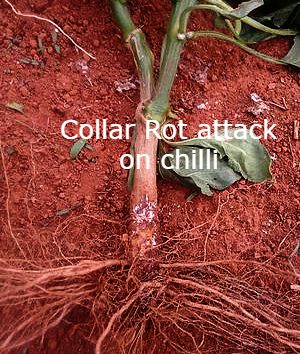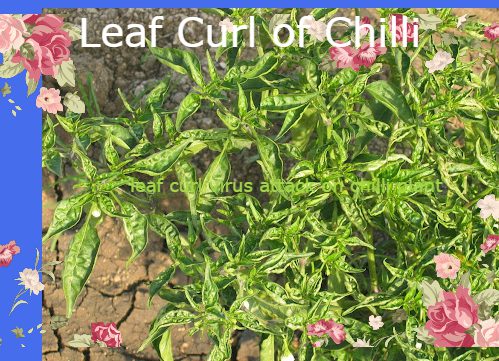Leaf Curl of Chilli
Leaf curl of chilli and Collar rot of chilli are widespread diseases caused by a soil-borne fungal pathogen. Both diseases cause economic losses.
History of Chilli
Chilli is a vegetable that is rich in vitamin C. Chilli cultivation started in Brazil and West Indies. After that, the cultivation of chilli was started in India. Apart from vitamin C, chilli contains vitamin A, vitamin B and a small number of other nutrients. As far as Pakistan is concerned, chilli was initially cultivated only in summer in Punjab. But now Hybrid varieties of chillies have been developed, which can be grown even in winter. It is a beneficial vegetable for farmers. However, some diseases are found in chilli crops, which cause a lot of damage to the chilli crop. Even if the crop is saved, the quality of chillies is very poor. That is why the control of these diseases is very important.
Chilli Disease and Their Control
Collar Rot of Chilli

This disease is spread by a certain type of fungus. It is called Sclerotium rolfsii Sacc fungus pathogen. This fungus attacks the stem of the chilli plant. The stem rots near the ground and the plant dries up. Due to collar rot disease, 16 to 79% loss of crop production is recorded annually to the severity of the disease. This disease occurs in all areas in the world where chilli is growing.
Collar Rot of Chilli Management
Top rot/root collar rot management is difficult due to soil properties and chemical methods are expensive and will not work well for the pathogen and also have a wide host range. Since chemical control of soil-borne pathogens is unsatisfactory, non-chemical crop disease control measures have received considerable attention. This can be effectively managed through the integration of biological and conventional methods, including the use of environmentally friendly biological controls.
The integration of biological seed protection with fungicides and insecticides involves reducing the number of pesticides that can stress and weaken the pathogen and make its sprouts more susceptible to antagonistic attack. and offer better control of seeds and seedling diseases rather than using them alone. Therefore, the integration of this approach plays an important role in the effective management of collar rot in chilli plants.
Leaf Curl of Chilli
The leaf curl of the chilli virus is one of the most dangerous diseases of chilli. Whitefly is the cause of leaf curl of chilli. The whitefly causes the spread of this disease. The most suitable time for the attack of this disease is when the amount of moisture in the air is high. Therefore, when it rains, the amount of moisture in the air becomes very high and this disease becomes invasive. July and August are the time for this disease to attack. Due to this disease, the fruit of the plant remains small and the leaves turn. There is a marked reduction in fruit production.
Chilli Leaf Curl Symptoms

Symptoms of leaf curl of chilli virus are characterized by raised leaf margins, yellowing of leaf veins, and reduced leaf size. In addition, the veins bulge with the shortening of the internodes and petioles. The older leaves become leathery and brittle. If the plant is infected early in the crop, the growth will be stunted leading to a significant reduction in yield. Fruit formation in susceptible varieties is rudimentary and distorted. The virus causes symptoms similar to the damage caused by eating thrips and ticks.
